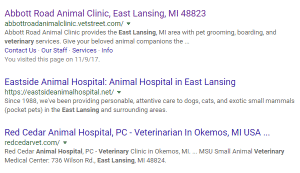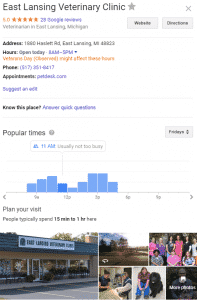Last Updated on May 25, 2022 by admin
I recently became a new cat mom and all the excitement also came with a lot of planning. One of the most important things to do was find a veterinarian that I trusted but also offers affordable services. I began searching online for veterinarians that offered new kitten packages or discounts on vaccines. Through my search, I realized a lot of veterinarians don’t optimize their websites. SEO is important for veterinarians because pet owners need to find a local veterinarian that can provide fast service in case something happens. Here are some local SEO tips for veterinarians who are looking to optimize their websites.
Keywords
For veterinarians, finding keywords to use is going to boil down to localization. There aren’t many variations of “veterinarian” that you can use unless your office specializes in large or small animals. If you’re not exactly sure how SEO works, it’s all about improving the visibility of your website in Google search organically. Google’s algorithms choose the most relevant and recent content to rank first over other sites. Choosing the right keywords is crucial to this process. When potential customers are searching for a veterinarian, they will most likely use phrases like “veterinarian near me” or they will look up a specific service they need. It’s important to add your location to your keywords because people want a local vet. You could also add location information for areas nearby that you get customers from. For example, your keywords for your home page could look something like:
“Veterinarian in East Lansing”
“Large animal clinic East Lansing”
“Animal hospitals East Lansing”
If your clinic also offers boarding or emergency services, you should add those keywords with location tags to their respective pages. If you don’t have specific pages for each service, add these and optimize them instead of just having an overall service page. You should sprinkle these keywords throughout the written content on each page, but make it sound natural and don’t “overstuff” keywords. You should also include keywords in the page title and meta description for the page. This is the snippet that gives a summary of what’s on that page that can help potential customers decide what websites to click on.

Google My Business & NAP information
Your business NAP information consists of your clinic’s name, address, and local phone number. This should be consistent on your website, Google My Business listing, and local citations. Google takes this information into account because it likes to rank websites with more consistent information higher. Start by adding schema to the footer of your website with your correct NAP information. You should also get a Google My Business listing or claim and verify your current one if you haven’t. Your GMB page should have all your correct NAP information, the correct categories such as “veterinarian”, “animal hospital”, any other service categories you offer like “pet boarding service”, a link for scheduling appointments (if applicable), and correct business hours. You wouldn’t want a customer to show up when you’re actually closed and then leave a bad review.
Once you do all this, your business will also appear in the map listings once everything is verified. This will help if a potential customer is looking for a veterinarian close to their home. Once your listing is all set up, you can then encourage satisfied customers to leave reviews. When I was looking for a vet, I always looked at the reviews first because I didn’t want to send my pet to a place where others had an overall negative experience.
Local citations, directories, and link building
Building inbound links to your site is a valuable tool for improving your rankings. Creating local citations and listing your clinic in local directories also shows your business is active and helps you get more reviews. Start by submitting your clinic to popular directories like Yelp, Mapquest, and Yellowpages. Continue this by getting listed in veterinarian or pet-specific directories like Bring Fido, Vet Street, and My Pet. You should also add a link to your website in these directories, if possible, to start with link building. Utilize city, local business, chamber of commerce or veterinarian organization websites to contact for adding a link to your website.
Social media
If your clinic has social media accounts, be sure to link to them on your website so customers can find them easier. The popular social media platforms are factored into search engine results, especially your Google Business Profile. Edit your NAP information on all your accounts so they’re consistent and include a link to your website. Be sure to add correct business hours to your Google Bussiness Profile and add photos. You should be posting regularly on your accounts so your customers can stay up to date with any new specials. Pet holidays are another great posting opportunity on social media. If you don’t have a social media presence yet, start by creating a Google Business Profile and a Facebook account.
Website blog
This can be on your list of things to do in the long term, but adding a blog on your website is beneficial to SEO. Google loves ranking websites higher that have new quality content. Especially if you use keywords within your blog posts that people search for often. Focus on blog posts that relate to your business or topics that customers regularly ask for help with. This could be the pros and cons of declawing your cat, how to start potty training your dog, or things new puppy owners should know.

Leave a Reply